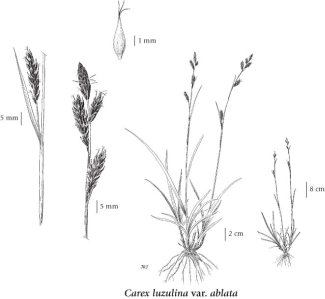Carex luzulina var. ablata Olney (L.H. Bailey) F.J. Herm.
woodrush sedge
Cyperaceae (Sedge family)
Introduction to Vascular Plants
woodrush sedge
Cyperaceae (Sedge family)
Introduction to Vascular Plants
Map
Distribution of Carex luzulina var. ablata
Click here to view the full interactive map and legend
Species Information
General:
Perennial, tufted herb from fibrous roots; stems 15-60 cm tall, much exceeding the leaves.
Leaves:
Sheaths blunt; blades flat, 3-9 mm wide, the lower ones slightly reduced.
Flowers:
Spikes 3 to 6, crowded, erect, 1-3 cm long, the upper unstalked, the lower short-stalked, the terminal one with male flowers, unstalked or nearly so, 1-2 cm long, the lower 2 to 5 spikes of female flowers, sometimes with male flowers towards the tips; bracts subtending the lowest spike with sheaths 1-4.5 cm long and blades 1-8 cm long, the blades much shorter than the inflorescence.
Fruits:
Perigynia lanceolate or narrowly egg-shaped, 3-5 mm long, 1-1.5 mm wide, smooth or often minutely rough, flattened, with 2 prominent nerves, the margins fringed with teeth near the tips, the beaks scarcely or shortly bidentate, about 1 mm long, 1/4 to 1/3 the length of the perigynia bodies; female scales egg-shaped, shorter than the perigynia, round at the tips, more or less fringed, purplish-black, the centres paler, the margins translucent; stigmas 3; achenes 3-angled, 1.4-1.7 mm long.
Illustration

If more than one illustration is available for a species (e.g., separate illustrations were provided for two subspecies) then links to the separate images will be provided below. Note that individual subspecies or varietal illustrations are not always available.
Illustration Source: The Illustrated Flora of British Columbia
Ecology
Ecological Framework for Carex luzulina var. ablata
The table below shows the species-specific information calculated from
original data (BEC database) provided by the BC Ministry of Forests and Range.
(Updated August, 2013)
The table below shows the species-specific information calculated from
original data (BEC database) provided by the BC Ministry of Forests and Range.
(Updated August, 2013)
| Site Information |
Value / Class |
||
|
Avg |
Min |
Max |
|
| Elevation
(metres) |
1808 | 940 | 2200 |
| Slope
Gradient (%) |
7 | 0 | 15 |
|
Aspect (degrees) |
140 | 70 | 360 |
| Soil
Moisture Regime (SMR) [0 - very xeric; 4 - mesic; 8 - hydric] |
3 | 2 | 6 |
| Modal
Nutrient Regime
Class |
C | ||
| #
of field plots species was recorded in: |
8 | ||
| Modal
BEC Zone Class |
ESSF | ||
|
All BEC Zones (# of stations/zone) species was recorded in |
AT(1), BAFA(2), BWBS(1), ESSF(3), IMA(1) | ||
|
Source:
Klinkenberg 2013
|
|||
Habitat and Range
Moist meadows and bogs in the montane to alpine zones; locally frequent in SW BC; S to WY, UT, NV and CA.Status Information
Synonyms
Synonyms and Alternate Names:
Carex ablata L.H. Bailey